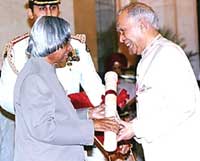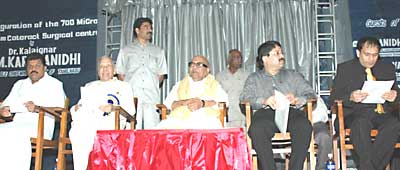Surgeon created legacy of excellence, family and service
In 1957, a young physician agreed to perform his first cataract surgery for just 250 Rs., all of which went to purchasing his first instruments to complete the surgery.
 Jaiveer Agarwal |
Using new instruments purchased in the market and a makeshift autoclave while operating in the patient’s home, the physician restored the man’s vision to 6/5 in that eye.
Fifty years later, that doctor, Jaiveer Agarwal, FICS, DOMS, FORCE, is celebrating his golden jubilee and looking back on the amazing growth he has seen in his practice – from one man to an institution.
The first operation
During a telephone interview with Ocular Surgery News, Dr. Agarwal still looks back on that first surgery as one of his greatest accomplishments.
“When I started my practice, I did not have any instruments. I did not have a knife. I did not have scissors or anything,” he explained. “A patient came to me, and he wanted the operation done by me. He said, ‘There’s only one condition, sir. I want the operation done in my house.’”
Because Dr. Agarwal did not have his own operating arena, he agreed, on the condition that the patient would give him a room that no one would enter for 3 days. He also instructed that washing would be done as he wanted for those 3 days.
Of those 250 Rs., his patient gave Dr. Agarwal 200 Rs. in advance.
“That 200 Rs. was very useful to me,” Dr. Agarwal said. “I went straight to the market, bought instruments for 800 Rs., gave the shopkeeper 200 Rs. in advance and told him I’d give him 600 later on.”
Next, he had to conquer the problem of sterilization, Dr. Agarwal explained.
“How to make an autoclave – that was my problem,” he said.
He used two big pots for boiling, one for keeping a variety of gowns and head covers and the other for boiling water, and large stones over the cover to give pressure. Thus, he managed to sterilize his tools and perform the operation.
“At that time about 50 years back, when I operated the first case, I did the latest technique of the time,” he said. “I delivered the lens with Arruga’s forceps tumbling the lens method intracapsular.”
Today, he said, “Nobody does that technique in my hospital. … Times have changed.”
When finished, Dr. Agarwal said, the eye on which he operated had a visual acuity of 6/5, in comparison with the previously operated eye, which was 6/6.
“That was my first operation,” he said. “That is the greatest achievement because it was only from there that I started building step by step.”
His vision and plan
Those small steps eventually led to a much larger vision, one that Dr. Agarwal created and expanded.
|
Images: Agarwal A |
“I started with almost zero rupees. I only had about 60 to 80 Rs. in my pocket when I came,” he said. “With that, we have been able to build an institution, my wife and I.”
When he completed his first surgery and began practicing, Dr. Agarwal said all he wanted was to obtain a slit lamp and begin building his institute.
“I did not have a slit lamp. Slit lamps cost, at that time, 60,000 Rs.,” he explained. “As a man who had not even $25, I couldn’t imagine 60,000 Rs.”
“Gradually, we built it up. Gradually, I bought a slit lamp. Gradually, I bought other instruments,” he said. “Today, you’d be happy to learn I bought an IntraLase (Advanced Medical Optics). Today it has been installed.”
In 1970, Dr. Agarwal went to Mexico for the International Congress of Ophthalmology and then to visit colleagues in Bogota, where he said it came to him that he must build an ophthalmic hospital in the shape of an eye in Madras (now known as Chennai).
“I accomplished it in ’75, exactly. Five years it took me to buy the land, then construct the hospital in the shape of an eye,” he said. “It is the only hospital in the shape of an eye in the world.”
“This is a complete institution by itself,” he said. “Surgeons come in from all over the world to learn the techniques here.”
Dr. Agarwal’s son, Amar Agarwal MS, FRCS, FRCOphth, now heads the institution his father created.
“When he started, it was just a single center. By the end of 2007, we will have 25 centers and more than 100 doctors in the group,” Prof. Amar Agarwal said in an e-mail interview with OSN. “The idea here is to create high-tech, quality eye care hospitals in the length and breadth of India.”
Dr. Agarwal today acts as the chairman of Dr. Agarwal’s Group of Eye Hospitals.
“Every day he is in the hospital supervising the administration and seeing if there are any flaws. He sees a few cases, and some very important people who come as patients are seen by him especially,” Prof. Amar Agarwal said.
A family venture
Along with Dr. Agarwal’s wife and son, his daughter, daughter-in-law and four grandchildren are all in ophthalmology.
He said another great moment in his life was when Prof. Amar Agarwal succeeded in becoming an ophthalmologist and passed the FRCS exam.
“That was the greatest joy in my life,” he said. “I can never forget that in my life, ever. The results [of those that passed] used to be 10% or 12% only, and he passed in that small 10% or 12%. It was a great joy to both me and my wife.”
Prof. Amar Agarwal said it was his father’s own dedication to the field of ophthalmology and education that pushed him to follow in his footsteps.
“Since childhood, he made me fascinated by this field,” Prof. Amar Agarwal said. “I still remember my first glaucoma surgery was done with him sitting next to me and teaching me. I must have taken more than an hour, but he would not get upset at any step.”
When asked what he admired most about his father while growing up, Prof. Amar Agarwal said: “His dedication to ophthalmology.”
“My father and mother both, even today, are totally dedicated to ophthalmology, and even today the hospital operation theater starts at 6 a.m. They live, eat and breathe ophthalmology,” he said.
Dr. Agarwal said he is proud that Prof. Amar Agarwal invented microphakonit, bringing their family and their institution to an international stage.
“My inner desire has always been that my children and my grandchildren, and if I have great-grandchildren, they also should become ophthalmologists,” Dr. Agarwal said. “I would like my children to prosper, my grandchildren to finish their education and join the hospital.”
“We have so many hospitals to look after now. We need more hands,” he said. “They’ll come through. They’ll continue.”
|
|
Widespread changes
“My father was involved actively as the secretary of the All India Ophthalmological Society and really took it to the next level,” Prof. Amar Agarwal said. “This helped all Indian ophthalmologists.” Later, Dr. Agarwal was elected president of the All India Ophthalmological Society.
Dr. Agarwal agreed, saying, “Indian ophthalmology has improved tremendously since then.”
“He was instrumental in getting custom duty exemption for eye instruments as secretary of the All India Ophthalmological Society,” Prof. Amar Agarwal explained. “Every doctor could buy eye instruments without paying any custom duty. That way, the whole country improved tremendously.”
Dr. Agarwal said even ophthalmologists in smaller towns throughout India now have lasers for treating their patients.
“If they had to pay the duty, they would have never bought it, but today, every ophthalmologist is buying instruments,” he said.
In recognition of Dr. Agarwal’s contribution to Indian ophthalmology, the All India Ophthalmological Society awarded him the Lifetime Achievement Award in 2001, and the Tamil Nadu Ophthalmic Association followed suit in 2002. The government of India gave him one of its highest honors in 2006, Padma Bhushan.
The Eye Research Center
In addition to the success of his institution of eye hospitals and the progress he initiated in Indian ophthalmology, Dr. Agarwal said his true “heart’s desire” came in the form of the Eye Research Center, established in 1978.
“I feel what I have gained from society I must give back in some form or another, so I started the Eye Research Center where I can collect funds and operate totally free,” he explained. “We give [patients] food. We give them IOLs. We give them medicine. We bring them. We drop them. Totally free for over 25 years.”
Patients are picked up from small towns, treated and taken back to their homes, Dr. Agarwal said. He said 90% of the procedures performed are cataract and 10% of procedures are made up of other diseases such as glaucoma, retinal detachment and corneal grafting.
For more information:
- Jaiveer Agarwal, FICS, DOMS, FORCE, is chairman of Dr. Agarwal’s Group of Eye Hospitals.
- Amar Agarwal, MS, FRCS, FRCOphth, is director of Dr. Agarwal’s Group of Eye Hospitals. They can be reached at 19 Cathedral Road, Chennai-600 086, India; +91-44-28116233; fax : +91-44-28115871; e-mail: dragarwal@vsnl.com; Web site: www.dragarwal.com.


